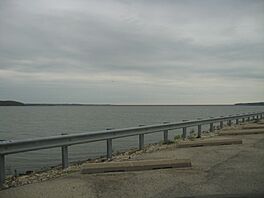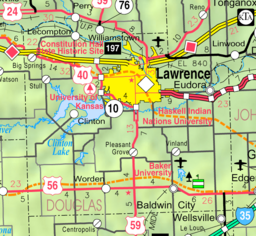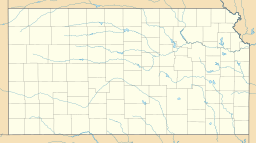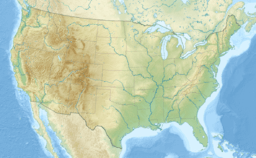Clinton Lake (Kansas) facts for kids
Quick facts for kids Clinton Lake |
|
|---|---|

Clinton Lake
|
|

|
|
| Location | Douglas County, Kansas |
| Coordinates | 38°53′51″N 95°23′18″W / 38.8975653°N 95.3883465°W |
| Type | Reservoir |
| Primary inflows | Wakarusa River, Rock Creek, Deer Creek |
| Primary outflows | Wakarusa River |
| Catchment area | 367 sq mi (950 km2) |
| Basin countries | United States |
| Managing agency | U.S. Army Corps of Engineers |
| Built | 1975 |
| Max. length | 9,550 ft (2,910 m) |
| Max. width | 940 ft (290 m) |
| Surface area | 7,000 acres (28 km2) |
| Average depth | 7 ft (2.1 m) |
| Max. depth | 55 ft (17 m) |
| Water volume | 110,400 acre⋅ft (0.1362 km3) |
| Shore length1 | 85 miles (137 km) |
| Surface elevation | 875.5 ft (266.9 m) |
| Settlements | Lawrence, Kansas |
| 1 Shore length is not a well-defined measure. | |
Clinton Lake is a large, human-made lake located near Lawrence, Kansas. It was created by building the Clinton Dam. The U.S. Army Corps of Engineers takes care of this big area of water and land, which is about 35 square miles (91 square kilometers).
Contents
Clinton Lake: A Man-Made Wonder
Clinton Lake is an important reservoir in Kansas. It helps control floods, provides drinking water, and offers many fun activities. The lake is a popular spot for people to enjoy nature and outdoor sports.
Why Was Clinton Lake Built?
Before Clinton Lake was built, the Wakarusa River valley often experienced big floods. These floods caused a lot of damage to towns like Belvoir, Bloomington, and Sigil. To protect people and property, the idea of building a dam was approved in 1962.
Construction of the dam began in 1972 and was finished in 1975. When the lake started filling with water in 1977, some old towns like Sigil, Belvoir, Bloomington, and Richland were covered. The lake slowly filled up, which helped create a good home for fish. By 1981, Clinton Lake was ready for its main jobs: flood control, water supply, and recreation.
How Clinton Lake Works
The main source of water for Clinton Lake is the Wakarusa River. This river flows into the lake from Shawnee County. After passing through the Clinton Dam, the Wakarusa River continues east. It eventually joins the Kansas River near Eudora.
Other smaller streams also feed into Clinton Lake. These include Deer Creek, Rock Creek, Washington Creek, Dry Creek, Coon Creek, and Camp Creek. Towns located near Clinton Lake include Clinton, Stull, and Lawrence.
Animals and Plants at Clinton Lake
The areas around Clinton Lake are full of wildlife. You can often see animals like white tail deer, quail, wild turkey, doves, rabbits, and squirrels in the woods.
Many different birds also visit the lake. Bald eagles, great blue heron, gulls, and cormorants are common. You might also spot migratory birds like American white pelicans and Canada geese at certain times of the year. The lake is home to many fish, including blue catfish, smallmouth bass, and channel catfish.
Fun Things to Do at Clinton Lake
Clinton Lake is a very popular place for outdoor fun. It has four parks managed by the U.S. Army Corps of Engineers and one park run by the city of Lawrence.
You can go boating, fishing, and enjoy other water sports on the lake. The land around the lake, including Clinton State Park, offers even more activities. These include mountain biking, camping, hiking, and playing disc golf. There's also an off-leash dog park, horseback riding, geocaching, hunting, picnicking, and wildlife viewing.
The Clinton Lake Museum is a cool place to visit. It's located near the town of Clinton in an old milk shed. This shed was once part of the old town of Bloomington.
Keeping Clinton Lake Healthy
People care a lot about keeping Clinton Lake clean and healthy. In 2002, a group called the Kaw Valley Heritage Alliance created a plan. This plan helps protect the water quality of the Wakarusa River watershed, which feeds into the lake.
The plan helps different groups work together. Their goal is to make sure the lake stays clean and can continue to provide water for over 100,000 people in northeastern Kansas.
See also




